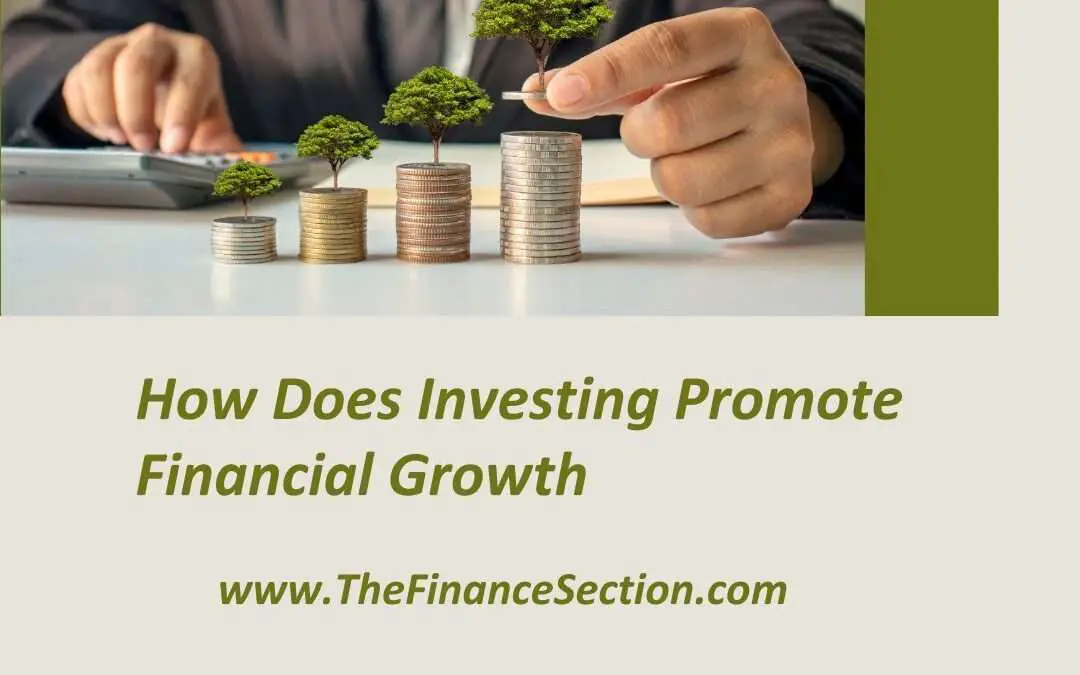Welcome to the world of investing, where the seeds of financial growth are planted, and the potential for wealth creation awaits. In this blog you will explore how does investing promote financial growth. Whether you’re a seasoned investor or just starting, understanding the key principles and strategies behind investing is crucial to unlock the full potential of your money.
The Basics of Investing:
Investing is like sending your money on an exciting adventure with the expectation of it returning with more friends. It’s all about putting your hard-earned cash to work by purchasing assets such as stocks, bonds, real estate, or mutual funds. These assets have the potential to grow in value over time, paving the way for your wealth to blossom.
Think of it this way: when you invest, you become the captain of your financial ship, charting a course toward a brighter future. You open the doors to a realm of opportunities for financial growth, where your money has the potential to multiply like bunnies at a magic show. But remember, investing isn’t a get-rich-quick scheme; it’s a journey that requires patience, strategy, and a pinch of courage.

Let’s dive into a real-life example to make things more exciting. Imagine you had invested $2,000 in a well-known technology company, let’s call it XYZ Inc., back in 2010. Fast forward to 2023, and that initial investment could have grown to a whopping $20,000!
Yes, you read that right. Your $2,000 would have transformed into ten times its original value, all thanks to the growth of XYZ Inc. and the power of compounding returns.
But wait, there’s more! Let’s take a trip into the world of “what if.” What if you had invested that same $2,000 in a different company, let’s call it ABC Corp., in the same year? Your investment could have skyrocketed even further in this alternative universe, reaching a jaw-dropping $50,000! That’s the magic of investing in the right company at the right time.
So, whether you’re a beginner or a seasoned investor, understanding the basics of investing is crucial. It’s like learning the rules of a thrilling game where the stakes are high, but the rewards can be even higher. By allocating your money wisely and embracing the power of growth, you set yourself on a path toward financial success.
Investing isn’t just for the elite; it’s a realm open to all who dare to enter. So, hop aboard the investment train, and let your money embark on a journey filled with potential, excitement, and the promise of financial growth. Your future self will thank you for it!
The Power of Compound Interest:
Compound interest is a powerful concept in the world of finance that can exponentially grow your money over time. It refers to the interest earned not only on the initial amount of money you invest or deposit but also on the accumulated interest that has been added to your investment over time.
In simpler terms, compound interest means earning interest on both your principal (the initial amount of money) and the interest that has already been earned.
As time goes on, the interest you earn gets added to your investment, allowing your money to grow at an accelerating rate.
Here’s an example to help illustrate the concept: Let’s say you invest $1,000 in a savings account that offers an annual interest rate of 5% compounded annually. After the first year, you would earn $50 in interest, bringing your total investment to $1,050.
In the second year, the 5% interest is calculated based on the new balance of $1,050, resulting in an additional $52.50 in interest. This process continues, with each year’s interest being calculated based on the updated balance.
Over time, the effect of compound interest becomes more pronounced. The interest you earn starts to earn its own interest, creating a compounding effect that accelerates your investment growth. The longer you stay invested, the more significant the impact of compound interest on your overall returns.
Compound interest can work in your favor when you’re investing or saving for the long term. It allows your money to grow faster than simple interest, which only applies to the initial principal. By harnessing the power of compound interest, you can watch your investment multiply and accumulate wealth over time.
So, understanding compound interest is essential, whether you’re saving for retirement, investing in stocks, or depositing money in a savings account. It’s like a superpower that can supercharge your financial growth and help you reach your financial goals faster.
Diversification: Spreading Your Wings for Growth
Diversification is a key strategy for any investor. It means spreading your money across different asset classes, sectors, and geographic regions. This helps to reduce your risk and increase your chances of success.

Here’s an analogy to help you understand diversification. Imagine you’re a bird who wants to fly across the ocean. You’re taking a big risk if you put all your eggs in one basket. If a storm comes and destroys your nest, you’re stranded. But if you spread your eggs across multiple nests, you’re much more likely to make it to the other side.
The same principle applies to investing. You’re taking a big risk if you put all your money in one stock. If the stock crashes, you could lose a lot of money. But if you spread your money across multiple stocks, you’re much more likely to weather the storm.
Of course, diversification doesn’t guarantee that you’ll make money. But it does help to reduce your risk and increase your chances of success.
Here are a few tips for diversifying your portfolio:
Invest in different asset classes
Asset classes are broad categories of investments, such as stocks, bonds, real estate, and cash. Investing in various asset classes can reduce your risk and increase your chances of capturing growth opportunities in different areas.
Invest in different sectors
Sectors are groups of companies that operate in the same industry. Investing in various sectors can reduce your risk and increase your chances of capturing growth opportunities in different industries.
Invest in different geographic regions
Geographic regions are different parts of the world. Investing in various geographic regions can reduce your risk and increase your chances of capturing growth opportunities in different parts of the world.
Diversification is an important part of any investment strategy. By diversifying your portfolio, you can reduce your risk and increase your chances of success.

Here are some real-world examples of how diversification can help you reach your financial goals:
Sure! Let’s explore some fun and relatable examples of how diversification can work wonders for your financial goals.
The Pizza Party Portfolio
Imagine you’re organizing a pizza party, and you want to offer a variety of flavors to satisfy everyone’s taste buds. You could stick with just one type of pizza, but what if some guests don’t like that flavor?
By diversifying your pizza options—offering a mix of classic, vegetarian, and even some adventurous toppings—you ensure that all your guests have something they enjoy.
Similarly, diversifying your investment portfolio by including different asset classes, such as stocks, bonds, and real estate, can help mitigate risks and increase the chances of achieving your financial goals.
The Travel Adventure Portfolio
Let’s say you’re planning a dream vacation to explore the wonders of the world. You could focus all your travel plans on one destination, but what if unforeseen circumstances disrupt your plans?
By diversifying your travel itinerary and visiting multiple destinations, you increase the excitement and adventure and reduce the impact of any unexpected events.
In the same way, diversifying your investments across different geographic regions and industries can protect your wealth from regional economic downturns or sector-specific challenges.
The Fantasy Sports Portfolio
Imagine you’re a die-hard fantasy sports enthusiast participating in multiple leagues. You could put all your eggs in one basket by selecting players from just one team, but what if that team underperforms?
By diversifying your fantasy sports team with players from different teams and positions, you spread your risk and increase your chances of success.

Similarly, diversifying your investment portfolio with a mix of stocks from various companies and industries can provide a cushion against poor performance from any single investment.
Remember, diversification is like adding spice to your financial journey. It helps to balance the flavors, mitigate risks, and increase the potential for long-term success.
Just as a well-diversified portfolio can weather different market conditions, a well-rounded pizza party, an adventurous travel itinerary, or a diverse fantasy sports team can enhance your experiences and maximize enjoyment.
By diversifying your portfolio, you can reduce your risk and increase your chances of success.
Capitalizing on Market Opportunities:
The stock market is a vast and ever-changing landscape. New opportunities are always emerging, and it can take time to know where to start. However, by doing your research and staying informed, you can identify potential investment opportunities that have the potential to generate significant returns.
One way to identify potential investment opportunities is to analyze market trends. What industries are growing? What companies are expanding into new markets? By understanding the current market landscape, you can identify companies that are well-positioned for growth.
Another way to identify potential investment opportunities is to study company financials. What are the company’s revenue and earnings? What is its debt load? By understanding a company’s financials, you can better understand its financial health and potential for future growth.
Finally, it is important to stay informed about economic developments. What is the overall state of the economy? What are the interest rates? By understanding the economic landscape, you can make better investment decisions.
Of course, no investment is guaranteed to be profitable. However, by doing your research and staying informed, you can increase your chances of success.
Here are some real-world examples of how investors have capitalized on market opportunities:
- In 2020, the COVID-19 pandemic led to a surge in demand for remote work tools. As a result, the stock price of Zoom Video Communications (ZM) surged by more than 500%.
- In 2021, the rise of cryptocurrencies led to a boom in the cryptocurrency market. As a result, the price of Bitcoin (BTC) surged by more than 500%.
- In 2022, the war in Ukraine led to a surge in the price of oil and gas. As a result, the stock price of Exxon Mobil (XOM) surged by more than 50%.

These are just a few examples of how investors have capitalized on market opportunities. By doing your research and staying informed, you can identify potential investment opportunities that have the potential to generate significant returns.
Mitigating Risks: The Importance of a Long-Term Approach:
Investing can be a great way to grow your wealth over time. However, it’s important to remember that risk is always involved. The stock market can be volatile, and even the best investments can lose value in the short term.
That’s why it’s important to take a long-term approach to investing. Don’t try to time the market or make quick profits. Instead, focus on building a diversified portfolio of investments that you can hold for years or even decades.
Taking a long-term approach can reduce your risk and increase your chances of success. Here are a few things to keep in mind:
Invest in your goals.
What are you saving for? Retirement? A down payment on a house? Once you know your goals, you can start building a portfolio to help you reach them.
Diversify your portfolio.
Don’t put all your eggs in one basket. Spread your money across different asset classes, such as stocks, bonds, and real estate. This will help to reduce your risk if one asset class performs poorly.
Rebalance your portfolio regularly.
As your investments grow, you’ll need to rebalance your portfolio to ensure it still aligns with your goals. This means selling some of your winners and buying more of your losers.
Stay invested.
The stock market is volatile, and there will be ups and downs. Don’t let short-term fluctuations scare you out of the market. Stay invested long-term, and you’ll be more likely to reach your financial goals.
Investing can be a great way to grow your wealth over time. Taking a long-term approach and following these tips can reduce your risk and increase your chances of success.
FAQs
- What are the benefits of financial investment?
Financial investment offers a treasure trove of benefits that can ignite your financial journey. Firstly, it has the potential to supercharge your wealth and open doors to a world of possibilities. With strategic investments, you can watch your money grow, bringing you closer to your financial goals.
Secondly, investing unlocks the power of compounding, where your earnings generate even more earnings over time. It’s like having a money-making machine that works tirelessly for you. Lastly, investing allows you to be part of the exciting world of business and innovation, supporting companies shaping the future.
- How does invested money grow?
Ah, the thrilling tale of how invested money grows! Picture your money as a sprouting seed, ready to blossom into a mighty tree of wealth. When you invest your hard-earned cash, it’s like giving that seed some magical fertilizer. As time passes, your investment starts to bear fruit, thanks to the power of compounding.
It’s like watching a snowball rolling down a hill, gaining momentum and size. Your initial investment grows and earns its own earnings, creating a magnificent growth cycle.
Just like a real-life example, imagine investing in a well-established company that experiences exponential growth, resulting in your investment multiplying many times over. With strategic investments and a pinch of patience, your money can multiply, helping you reach your financial dreams.
- Is investing part of financial planing?
Yes, investing is part of financial planning. Financial planning is setting financial goals and developing a plan to achieve them. Investing is one of the tools that can be used to achieve financial goals.
There are many different types of investments, and the best investment for you depends on your circumstances and goals. For example, if you are saving for retirement, you may want to invest in stocks or mutual funds. If you are saving for a down payment on a house, you may want to invest in real estate.
It is important to do your research and understand the risks involved in investing before you make any decisions. You should also speak with a financial advisor to get personalized advice based on your circumstances.
- Why is growth investing important?
Growth investing is a type of investment strategy that focuses on stocks expected to grow faster than the overall market. This type of investing can be a great way to build wealth over time, as it can help you capture the gains that come from rapidly expanding companies.
There are a few reasons why growth investing is important. First, it can help you to beat the market. The overall market tends to grow relatively slowly, so if you can find stocks that are growing even faster, you can potentially generate outsized returns.
Second, growth investing can help you to diversify your portfolio. If you only invest in large, established companies, your portfolio may be vulnerable to a decline in the overall market. However, if you also invest in growth stocks, you can help to reduce your risk.
Finally, growth investing can be a lot of fun. Investing in companies that are changing the world or disrupting their industries is exciting. And if you’re successful, you can generate significant wealth.
Growth investing may be a good option for you if you’re looking for a way to build wealth over time and have some fun along the way.

